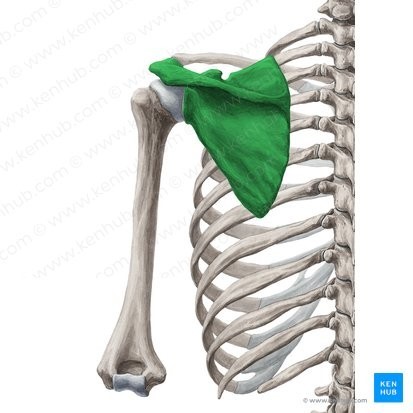Which of the following bones is NOT part of the axial skeleton?
Sacrum.
Hyoid.
Ribs.
Scapula.
The Correct Answer is D
The scapula is a flat bone that forms part of the shoulder girdle and belongs to the appendicular skeleton.
The appendicular skeleton consists of the bones of the limbs and the girdles that attach them to the axial skeleton.

Choice A is incorrect because sacrum is a triangular bone that forms the posterior part of the pelvic girdle and belongs to the axial skeleton.
The axial skeleton consists of the bones of the head and trunk of a vertebrate.
Choice B is incorrect because hyoid is a U-shaped bone that lies in the anterior neck and belongs to the axial skeleton.
The hyoid bone supports the tongue and provides attachment for some muscles of swallowing and speech.
Choice C is incorrect because ribs are long curved bones that form the rib cage and belong to the axial skeleton.
The ribs protect the thoracic organs and assist in breathing.
Nursing Test Bank
Naxlex Comprehensive Predictor Exams
Related Questions
Correct Answer is ["Ischial tuberosity"]
Explanation

The ischial tuberosity is a bony prominence located at the base of the pelvis.
It is the part of the pelvis that bears weight when sitting and is commonly referred to as the "sitting bone." The ischial tuberosity is attached to several important muscles, including the hamstrings and the adductor magnus, which play a crucial role in hip extension and thigh adduction, respectively.
The ischial tuberosity is also an important landmark for identifying the sciatic nerve, which runs in close proximity to the bone.
Injuries to the ischial tuberosity can occur as a result of prolonged sitting, direct trauma, or repetitive stress, and can cause pain and discomfort in the buttocks and hips.
Correct Answer is ["The shoulder and hip are examples of ball and socket joints"]
Explanation
Briefly describe the structural differences between the two and how this impacts the available motions at each joint.
Answer and explanation.
The shoulder and hip are both ball and socket joints, which means they have a round end of one bone that fits into a small cup-like area of another bone.
However, the shoulder joint is more mobile than the hip joint, which means it can move in more directions, but it is also more unstable and prone to dislocation.
The hip joint is more stable than the shoulder joint, which means it can support more weight and force, but it has less range of motion.
The shoulder joint allows for eight different movements: flexion, extension, abduction, adduction, internal rotation, external rotation, horizontal abduction, and horizontal adduction.
The hip joint allows for six different movements: flexion, extension, abduction, adduction, internal rotation, and external rotation.
The shoulder joint has a larger socket than the hip joint, which gives it more freedom of movement.
The hip joint has a smaller socket than the shoulder joint, which makes it more secure and stable.
The shoulder and hip joints are both important for many daily functions and activities.
They are also both susceptible to injuries and conditions such as osteoarthritis, inflammatory arthritis, and labrum tears.
Whether you are a student looking to ace your exams or a practicing nurse seeking to enhance your expertise , our nursing education contents will empower you with the confidence and competence to make a difference in the lives of patients and become a respected leader in the healthcare field.
Visit Naxlex, invest in your future and unlock endless possibilities with our unparalleled nursing education contents today
Report Wrong Answer on the Current Question
Do you disagree with the answer? If yes, what is your expected answer? Explain.
Kindly be descriptive with the issue you are facing.
